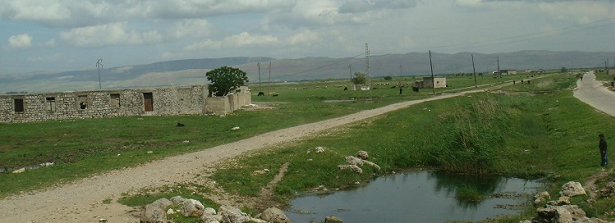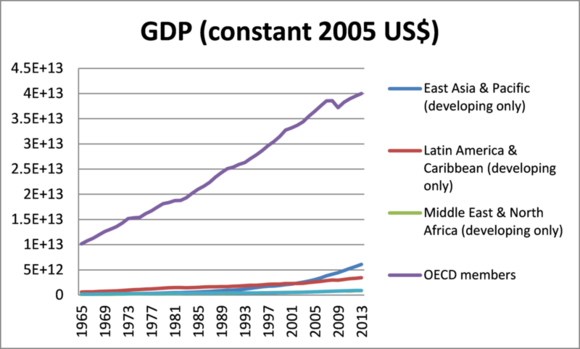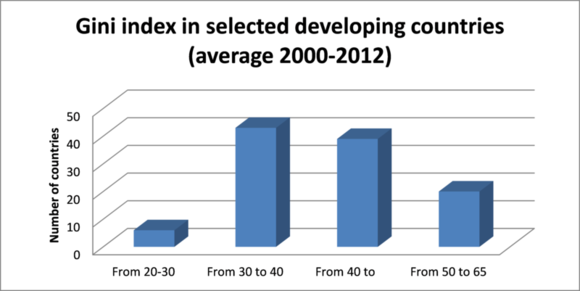Territorial Approach: A paradigm shift in policy making to fight hunger, poverty and inequality

Income inequality is among the world’s most pressing issues, as highlighted in the recent Report of the United Nations Secretary-General on the Post-2015 Agenda.1 In developing countries, income inequality is synonymous with spatial disparity, which in most cases coincides with rural-urban disparities. Most food insecure, poor and vulnerable people live in rural areas. The failure of sectoral strategies to fight hunger, poverty and inequality calls for new approaches to rural development. Could a territorial approach be a suitable alternative?
This editorial article was written by Vito Cistulli for The Broker and was published on February 26, 2015.
Slow income convergence and increasing inequality
Over the past few decades, and particularly in the new millennium, the GDP of developing countries has grown faster than that of advanced countries and progress has been made in reducing extreme poverty and food insecurity in developing countries.2 However, eradicating hunger is proving to be more difficult than expected. As of 2012–14, around 805 million people are still vulnerable to food insecurity and 1.2 billion are living on less than US $1.25 per day.3 Moreover, the income gap between developing countries and advanced countries grew until recently (Figure 1) and income inequality within countries is increasingly diverging4, as measured by the Gini index (Figure 2). As a result, ‘hundreds of millions of people have real incomes that are not much higher than they were 200 years ago’.5
Figure 1

Figure 2

The sustained economic growth of developing countries over the last two decades is yet to converge into more equality in incomes, and disparaties and inequalities (between and within countries) are causing increasing social and political problems. As Dani Rodrik puts it in his paper The Future of Economic Convergence, ‘convergence is anything but automatic’.6 In fact, there is strong evidence to state that economic growth does not lead automatically to a more equal distribution of income and wealth.
Why geography matters
Disparities and inequalities exist because the socioeconomic and policy dynamics of cities, regions, and countries are different from each other and often unique to a particular geographic area. Each locality or territory has a set of physical, human, financial, institutional and cultural resources that jointly constitute its asset endowment and development potential. Because each geographic area is unique, the outcome of a policy implemented in one area will not be the same as the outcome in another area, both in terms of both the direction (positive or negative) and magnitude of the impact. For example, if a government decides to expand its social protection policy on child undernutrition to a new district, the outcome of the policy will depend on a number of factors, such as the infrastructure and services present in that area. The outcome in an area where infrastructure (roads, clinics, schools, etc.) and services (access to water, etc.) are poor will vary from the outcome in an area that has good infrastructure and services. Even when the outcome is positive in both areas, it may not be of the same magnitude.
The variety of economic, political and social situations in different geographical areas is not systematically taken into account in food security and poverty reduction policy making, resulting in a disjunction between decision-making at the central level and implementation at the local level, as well as between the anticipated and actual outcomes of strategies and policies.
The role of a territorial approach
A vast and growing body of literature has highlighted the merits of a more localized approach to development. However, the literature concerning the application of this approach to food security and rural poverty reduction policies is much weaker.7 Yet, there are strong arguments for a more localized approach to hunger and poverty reduction.
Food security and poverty are multi-dimensional, multi-sectoral and multi-level concepts, which cannot be addressed through only a sectoral approach. For many years, ‘food security’ has been used synonymously with ‘food supply’ or ‘food self-sufficiency’, hence the focus on increasing agricultural production. While food production and agricultural productivity remain important challenges for food security and rural poverty reduction in developing countries, in the past few decades an increased focus has been placed on access constraints to food. These constraints are generally caused by economic, social, cultural and physical factors that are not related to the agricultural sector and strongly associated with the uniqueness of local conditions.
To address this, the territorial approach proposes a systemic method that maps the diversity of the local socioeconomic dynamics, understands the root causes of food insecurity and poverty, assesses the diversity of response capacities to policy reforms and shocks, and ultimately reduces the risk of policy failure and improves the allocation of scarce resources. Under this approach, ‘territories’ cease to be passive entities characterized by locational advantages and become dynamic socioeconomic entities made of economic and social agents that offer products and services and concur in boosting the competitiveness of their space. By placing the focus on intangible factors (human capital and knowledge) and on relational and network factors (cooperation, partnerships, local culture, local vocations, communication networks, etc.), and by involving partners and stakeholders in determining the strengths and weaknesses of their location, as well as the opportunities for development, the territorial approach stresses the importance of negotiation, consensus-building and conflict resolution. As such, it promotes inclusive decision-making and empowers local populations through their formal and informal organizations and networks (see also Predictions on the G7+ process).
From this perspective, the territorial approach does not replace previous approaches applied under various names by the Food and Agriculture Organization (FAO) and other international organizations,8 but is an evolution of these approaches aimed at filling some of the gaps that make such approaches unfit to address the complexity of food security and poverty. The main difference between the territorial approach and other approaches is a shift from a strong sector-based and supply-side focus towards a more holistic approach that takes into account other development opportunities, the interlinkages between the various dimensions of sustainable development (social, economic, environmental, institutional), and the possible tensions and trade-offs between these dimensions, the stakeholders, and the policy options, as well as between local preferences and national priorities (i.e. infrastructure) (see also From complex to simple: the water-energy-food nexus).
The ‘4Is’ model
For development strategies for food security, nutrition and rural poverty reduction to be effective under a territorial approach, four prerequisites must be in place – also called the four pillars of the 4Is model – namely: institutions and multi-level governance, information, inclusion and innovation.
Institutions and multi-level governance: The success of rural development policies depends on the capacity of the different stakeholders (local, national and international) to coordinate their actions within a broad governance framework. A multi-level governance system that ensures coherence between local socioeconomic dynamics and national policies and institutional structures and that facilitates the establishment of partnerships, a clear accountability system, and an effective monitoring and evaluation process is more likely to promote effective and inclusive food security and nutrition policies.
Information: An efficient system of information, tools and approaches for analyzing the different characteristics and territorial assets of rural areas is fundamental to an integrated and territorial approach aimed at strengthening the effectiveness of responses to rural poverty and food insecurity, while taking into consideration the territorial dynamics and their implications for food and nutrition security and rural poverty.
Inclusion: The World Bank’s report, Reshaping Economic Geography,9 concluded that ‘For rapid, shared growth, governments must promote economic integration which, at its core, is about the mobility of people, products, and ideas’, suggesting the importance of integrating remote areas with leading areas through the increased mobility of people and goods. The report also stressed that agglomeration is a prerequisite for attracting investment and ensuring a high return on investment, which would, in turn, generate employment opportunities and overall development. The World Bank concludes that urbanization is the most effective development path as it meets the three prerequisites for agglomeration economies: short distance, high population density, and fewer divisions or market restrictions. While agglomeration economies are an incontrovertible prerequisite for development, the urbanization paradigm suggested by the World Bank remains controversial for several reasons: it does not take into account the environmental and health costs of urban congestion and it underestimates the irreversible effects of urbanization on marginal and remote areas (e.g. the abandonment of rural areas in Algeria), as well as the ‘emulation’ effect of investment, or the process through which investments go where others have already invested because it is assumed that risks are minimized. Moreover, there is little evidence that the expected spill-over effect of the urbanization model on peripheral areas has taken place. Another important factor is the extent to which the rapidly increasing virtual connectivity can partially replace the physical connections subsumed in the urbanization model. Today, many services such as market price information, banking, the purchase of goods and ‘teleworking’ can be provided on line and from a distance. Virtual connectivity is already a reality, including in developing countries and there is increasing evidence that it is enhancing opportunities in the most disadvantaged areas. However, inclusion is not just about agglomeration economies. The territorial approach, as opposed to the urbanization model, emphasizes inclusive processes whereby local communities, people and their organizations are in the driver’s seat in decision-making processes.
Innovation: Innovation is increasingly being recognized as a fundamental aspect of food security and rural poverty reduction. It encompasses technological changes, including the abovementioned key role played by information and communications technology (ICT), as well as social innovation. Of particular importance are bottom-up social innovations that are based on the capacity of local communities to share knowledge, value local entrepreneurship, and develop social networks and social capital – all of which will help local communities to develop new knowledge, ideas and projects that are culturally acceptable, environmentally sustainable and technically feasible. The innovative capacity of local communities is directly related to the level of participation of the local communities in the decision-making process.
Lessons learned and the way forward
Over the past two decades the territorial approach has gained increasing momentum as a conceptual and operational framework for addressing challenges and achieving more inclusive (social and spatial) growth. FAO’s experience in rural development and community-based development has laid the foundations for a more comprehensive territorial approach to food security and nutrition. FAO has recently started applying this approach in some countries with encouraging initial results. In a rural development strategy prepared by the Government of Syria in 2012 with the support of FAO, the United Nations Development Programme (UNDP), and the United Nations Industrial Development Organization (UNIDO) the application of a territorial approach highlighted that food security and poverty in the area analyzed was strongly correlated to human capital, labour market efficiency and rural diversification. The paper also highlighted that investments in these three sectors would trigger the development of the agricultural sector, which remains the main source of livelihood in those areas.
Following global concerns about the growing inequality and its implications for social and political stability, commitment to social and spatial inclusion in development approaches is increasing at global, regional and country levels. The aforementioned UN Secretary-General report states that ‘we leave no one behind, ensuring equality, non discrimination, equity and inclusion at all levels’ and that ‘it will be important to consider that many of the investments to achieve the SDGs [Sustainable Development Goals] will take place at the sub-national level and led by local authorities’.10 The SDGs stress that regionally and locally-relevant good practice models for each goal would help countries develop their support for SDGs. The 4th High Level Forum on Aid Effectiveness held in Busan in 2011 placed particular emphasis on the key role played by local governments in linking citizens with governments and in ensuring broad-based and democratic ownership of national development agendas. At the regional level, the 4th edition of the African Competitiveness Report (2013)11 points that spatial inclusion that ‘create regional and national spatial linkages by building infrastructure needs to be mindful of the unequal distribution of resources between the coastal and landlocked countries of the continent, and to consider the challenge of spurring equitable growth in both rural and urban areas’.
At the country level, the governments of most developing countries are engaging in decentralization reforms and in the strengthening of more inclusive approaches in policy making. Another opportunity resides in the technological advantage. As mentioned above, developing countries can take advantage of ICT (e.g., Internet, mobile phones, satellite technology, and computerized systems) to address and analyse complex issues such as territorial analysis.
However, the political will to mainstream territorial approaches into policy making and the capacity to implement such approaches are still generally weak in all the four pillars of the 4Is model. Efforts should be increased to create evidence-based knowledge and raise awareness of the benefits of a territorial approach to food security and rural poverty reduction policies. Capacities need to be strengthened in the use of advanced technologies, in the generation of adequate information and monitoring systems, and in the use of appropriate analytical methods. Institutions at both the central and local level need to be strengthened to ensure effective accountability systems. Towards this, FAO, in close cooperation with other international organizations, has stepped up its efforts to support member countries in developing an enabling environment for territorial-based inclusive and effective food security and poverty reduction policies.
Footnotes
- 1. UN Secretary-General (2014) The road to dignity by 2030: Ending poverty, transforming all lives and protecting the planet. New York: United Nations.
- 2. UN (2013) The Millennium Development Goals report. New York: United Nations.
- 3. FAO (2014) The state of food insecurity in the world 2014. Rome: Food and Agriculture Organization.
- 4. Dervis, K. (2012) ‘Convergence, interdependence, and divergence.’ Finance & Development 49 (3): 10–14.
- 5. Milanovic, B. (2012) Global income inequality by the numbers: In history and now – an overview. The World Bank Development Research Group Poverty and Inequality Team.
- 6. Rodrik, D (2011) ‘The future of economic convergence’. Paper prepared for the 2011 Jackson Hole Symposium of the Federal Reserve Bank of Kansas City, 25–27 August 2011.
- 7. Cistulli, V.; Rodriguez-Ose, A; Escobar, G; Marta, S and Shejtman, A (2014) ‘Addressing food and nutrition security by means of a territorial approach.’ Food Security 6 (6): 895.
- 8. The most common approaches used include the integrated rural development approach, livelihood approach, community development approach, local development approach and landscape approach. The territorial development approach has also been widely used in recent decades, mainly in Latin America.
- 9. World Bank (2009) Reshaping economic geography. Washington, DC: World Bank.
- 10. UN Secretary-General (2014) The road to dignity by 2030: Ending poverty, transforming all lives and protecting the planet. New York: United Nations.
- 11. World Economic Forum, African Development Bank, and World Bank (2013) African competitiveness report: Connecting Africa’s markets in a sustainable way. Geneva: World Economic Forum.





